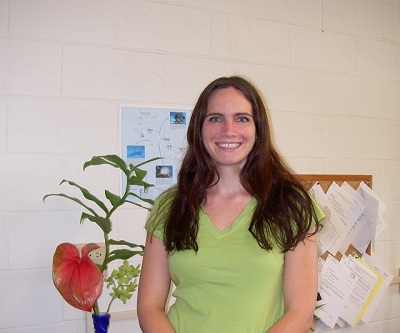
Name Amy Eggers
- Education B.S., Biology, Certified as a Technologist of Molecular Biology by the American Society for Clinical Pathology, MB (ASCP)
- Target Audience Middle School

Gilligan's Island has gone from uncharted territory to biologists' paradise. Read more to find out what makes being a laboratory manager at the Hawaii Institute of Marine Biology on beautiful Coconut Island in Kaneohe Bay, Oahu such a cool job!
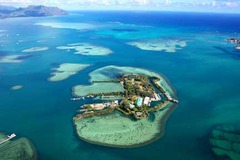 I am the manager of the Evolutionary Genetics Core Facility at the Hawaii Institute of Marine Biology (HIMB), located on the beautiful Coconut Island in Kaneohe Bay, Oahu. The purpose of this facility is to provide technical services and support for researchers at HIMB, the University of Hawaii system, as well as other institutions worldwide (such as NOAA and the USDA). The scientific instruments and equipment contained at the Core facility are available for general use of researchers, and includes: a Microarray to measure gene expression levels, a Spectrophotometer to measure DNA, RNA and proteins, and real time PCR instrument to quantify DNA. I am available on site to offer assistance with instrument protocols and troubleshooting.
I am the manager of the Evolutionary Genetics Core Facility at the Hawaii Institute of Marine Biology (HIMB), located on the beautiful Coconut Island in Kaneohe Bay, Oahu. The purpose of this facility is to provide technical services and support for researchers at HIMB, the University of Hawaii system, as well as other institutions worldwide (such as NOAA and the USDA). The scientific instruments and equipment contained at the Core facility are available for general use of researchers, and includes: a Microarray to measure gene expression levels, a Spectrophotometer to measure DNA, RNA and proteins, and real time PCR instrument to quantify DNA. I am available on site to offer assistance with instrument protocols and troubleshooting.
The facility also offers genomic services including Sanger and Illumina sequencing and fragment analysis. (DNA Sequencing determines the order of nucleotides in DNA molecule, and fragment analysis identifies DNA fragments based on size.) These services can be used for various applications such as genome sequencing, mutation detection, gene identification and expression, and genotyping.
While I work at a marine institute, I am not a marine biologist. My degree is in biology, and my work experience and expertise is in molecular biology, which is the study of biology at the molecular level.
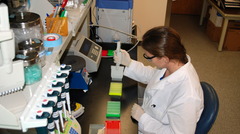 I am a lab rat. I love working in the lab, learning new protocols or experiments, troubleshooting, and discovering how and why things work.
I am a lab rat. I love working in the lab, learning new protocols or experiments, troubleshooting, and discovering how and why things work.
There isn't one! For me, every day is different. One day I could be running experiments on coral gene expression or shark and dolphin genetics for researchers, and the next I could be discussing designs for research projects, or educating researchers about the technologies used in the facility. What I do each day depends on the needs of the people using the facility.
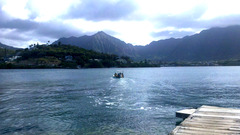 The only thing that doesn't change for me is my daily water commute. To access my lab I must go by boat, which runs from the main island of Oahu to the famous Coconut Island. Coconut Island is best known from its appearance during the opening credits of the 1960's TV show "Gilligan's Island"! I love the boat ride because I get to take in beautiful views of the Koolau mountains.
The only thing that doesn't change for me is my daily water commute. To access my lab I must go by boat, which runs from the main island of Oahu to the famous Coconut Island. Coconut Island is best known from its appearance during the opening credits of the 1960's TV show "Gilligan's Island"! I love the boat ride because I get to take in beautiful views of the Koolau mountains.
I get to contribute to many different research projects. Without the equipment, services, and support provided by my laboratory, many researchers wouldn't be able to conduct their experiments. The instrumentation and services offered by my laboratory are important tools for scientific research being conducted in Hawaii.
My favorite subject was math because I understood it and was good at it. Mathematics made more sense to me than other subjects.
There wasn't a specific moment that I knew I wanted to become a scientist, but my interest in science started early. In sixth grade I got to dissect a cow eyeball in science class. We looked at all of the components of the eyeball, and studied their individual functions. I thought it was so cool that I decided to bring the eyeball home and save it in my refrigerator. That's when I also learned that my mother is a screamer!
Throughout middle school and high school I really enjoyed math and physics classes. In college I discovered that science classes were really my favorite, and once I got my first job in a laboratory, everything really fell into place. I was able to work at my own pace in a calm, quiet setting. I also discovered I was good at precision work, and I knew at that point that I had found where I belonged.
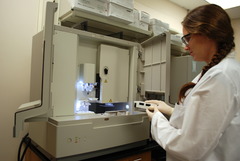 My biggest challenge was learning patience. Research can be a long process, and there are many small but important steps involved in reaching a goal. I had to learn that each step requires time, patience and accuracy. You have to work for your discoveries!
My biggest challenge was learning patience. Research can be a long process, and there are many small but important steps involved in reaching a goal. I had to learn that each step requires time, patience and accuracy. You have to work for your discoveries!
I was most inspired by my former neighbor, Tanya Vickers. Tanya taught biology at the University of Utah, and assisted me in getting my first lab job, as well as providing great encouragement and support. I am convinced that I wouldn't be where I am today without Tanya's guidance.
I recommend joining a science club either in your school or community. Science clubs help students explore different areas of science and introduce them to the scientific method, which is very important to all scientists! I also suggest attending science related events or facilities in your community, including bird sanctuaries, arboretums, and zoos. For example, the Hawaii Institute of Marine Biology, where I work, has a walking tour that allows people to learn about various marine organisms, visit a shark pond and a touch-pool full of marine invertebrates.
Go outside and investigate the insects and animals around you. Research them and discover what they eat, where they live, what their life cycles are like, and how they work together. Bugs are not as creepy as you think. Discover what makes bugs so important right in your backyard!
I think it is important to understand many scientific subjects before choosing the one you like most, so take as many different types of science classes as you can. These classes can include Biology, Chemistry, Physics and Math. Many high schools are now offering courses which give students an opportunity to gain experience in the field as well as in the classroom, so ask your counselor if any of these courses exist in your school.
There are always exciting discoveries in science and it is changing with each new discovery. The Human Genome Project took years to complete and now scientists are able to sequence the human genome in less than a month. It is exciting to think where sequencing technology will be in another ten years. Who knows, we may be able to sequence the genome in less than a day!
Gene: DNA is composed of genes. Genes are the basic unit of heredity; a linear sequence of nucleotides along a segment of DNA that provides the coded instructions for synthesis of RNA, which, when translated into a protein, leads to the expression of hereditary character.
Gene Expression: Gene expression is the process of taking information from a gene into messenger RNA, and then to a protein.
Genome: Every organism has a genome. It is the material required to create a full set of chromosomes; all the inheritable traits of an organism.
Invertebrates: An invertebrate is an animal without a backbone.
Molecular: Molecular is used to describe something that is made up of similar parts, or molecules.
NOAA: National Oceanic and Atmospheric Administration
Physics: Physics is the science that deals with matter, energy, motion and force.
Sequencing Technology: Full name is "Sanger Dideoxy Terminator Sequencing" has provided the backbone technology for DNA sequencing for the last 40 years. This DNA sequencing was originally created by Biochemist, Fred Sanger and named in his honor. (http://www.sanger.ac.uk/resources/technologies/sequencing.html)
USDA: United States Department of Agriculture
Mariana Fuentes always loved working with animals, but she didn't know …
Do you like fish, going on cruises, or getting your favorite clothes at…
Ever wondered what those people who take care of animals in the aquariu…